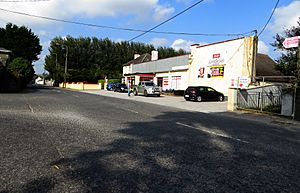Richard Pyne facts for kids
Sir Richard Pyne (1644 – December 1709) was an important Irish landowner, lawyer, and judge. He served as the top judge in Ireland, known as the Lord Chief Justice of Ireland, from 1695 until he passed away in 1709.
Contents
Meet the Pyne Family of Mogeely
Richard Pyne was born in County Cork, Ireland. He was the fourth son of Nicholas Pyne of Mogeely, a place near Castlemartyr. His mother was Jane Tynte, whose family was connected to the powerful Boyle family, including the Earl of Cork.
Richard's grandfather, Henry Pyne, came from England around 1589. He received a large area of land in County Cork and built Mogeely Castle there. This castle doesn't stand anymore, but you can still find some small parts of it. Henry had some tough times, like when he had to quickly escape back to England during a conflict in 1598. He was even accused of helping the Irish rebels, but there was no proof of this. Many other settlers also fled for safety during that time.
Henry returned to Ireland around 1601 and became successful. He sometimes had disagreements with other important people, like Sir Walter Raleigh and Richard Boyle, 1st Earl of Cork, who later owned Raleigh's lands. Henry was known for being a clever businessman.
Richard's Education and Early Career
Richard Pyne started his studies at Queen's College, Oxford in 1662. In the same year, he began training to become a lawyer at the Middle Temple in London. He became a lawyer in England in 1669 and then in Ireland in 1674. That same year, he inherited land from his brother Henry, who had died without children.
By 1685, Richard became a King's Counsel, which meant he was a senior lawyer who advised the Crown. He also worked for the Irish tax department. Even though he worked for King James II, who was Catholic, Richard was a strong Protestant. He also supported the Whig political group, which later backed the Glorious Revolution of 1688. This revolution changed who was king in England.
Richard's Time as a Judge
After a big battle called the Battle of the Boyne in 1690, Richard Pyne was chosen for an important role. He became one of the three people in charge of the Great Seal of Ireland, which was used to make official documents legal. He also worked as a judge in Ulster.
In 1691, King William III personally asked for Pyne to become the Chief Justice of the Irish Common Pleas. This was a big honor! He was knighted in 1692, becoming "Sir Richard Pyne."
Sir Richard was promoted again in 1695 to become the Lord Chief Justice of the King's Bench for Ireland. This was the highest judicial position in Ireland. He held this job until he died. Towards the end of his life, he wasn't very well and often visited Bath in England, hoping to feel better.
As a judge, Sir Richard Pyne handled many cases. For example, in 1697, he oversaw the trial of Colonel James Waller, who was accused of stealing money. Sir Richard also had some disagreements with important church leaders, like William King, who later became the Archbishop of Dublin.
Sir Richard was recognized for his work. In 1706, he was a trustee for the King's Inns, a place where lawyers are trained. In 1707, he was given the Freedom of the City of Dublin, a special honor from the city. He passed away in December 1709 at his home in Surrey, England.
Sir Richard's Properties
Sir Richard Pyne owned a lot of land in County Cork. He mainly lived at Waterpark, near Carrigaline. He also bought other estates, like Ardra and Ballinaneala. In 1703, he bought Blarney Castle, but he sold it just a few months later. He heard a rumor that the old owners might get it back, but this turned out to be false.
He also owned land in England, including an estate at Ashley in Surrey, where he died. Sir Richard is also remembered for starting the building of Ballyvolane House near Fermoy. This house was finished long after he died.
Sir Richard's Family
Sir Richard Pyne married Catherine Wandesford. Her grandfather, Christopher Wandesford, was a very important statesman who served as Lord Deputy of Ireland.
Sir Richard and Catherine had one son, Henry. Henry married Anne Edgecumbe, whose brother later became Richard Edgcumbe, 1st Baron Edgcumbe. Henry and Anne had a daughter named Anne, who married Sir Henry Cavendish. Their descendants later became known as the Baron Waterpark family.
Sir Richard also left a lot of his land, including Ballyvolane, to his nephew, Robert Wakeham. Robert was the son of Sir Richard's sister, Jane. As a condition of inheriting the land, Robert added "Pyne" to his name, becoming Robert Wykeham Pyne. The Wykeham Pynes lived at Ballyvolane for many years.
What People Thought of Sir Richard
In 1698, a writer named John Dunton visited Dublin. He wrote good things about most of the judges in Ireland, including Sir Richard Pyne. Dunton said they were "men whose reputation is such that no one complains of them," meaning people thought they were fair and honest.
There is still a painting of Sir Richard Pyne in his judge's robes, made by an artist named William Gandy.
Images for kids



